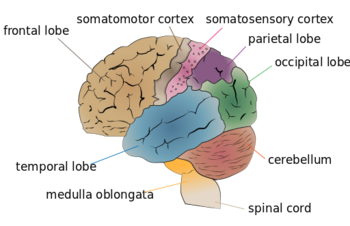Developmental Coordination Disorder (DCD): Difference between revisions
No edit summary |
No edit summary |
||
| Line 19: | Line 19: | ||
== Mechanism of Injury / Pathological Process == | == Mechanism of Injury / Pathological Process == | ||
[[File:Neuroanatomy.png|right|frameless|350x350px]] | [[File:Neuroanatomy.png|right|frameless|350x350px]] | ||
Limited evidence exists related to the etiology of DCD. It is hyptothesized that children born pre-term or very low birth weight are at higher risk of motor impairment, including DCD, and smaller volumes of neuroanatomical structures, such as the cerebellum and basal ganglia have been found in children with DCD, suggesting the possibility of delayed development of these areas in the brain. <ref>Dewey D, Thompson DK, Kelly CE, Spittle AJ, Cheong JL, Doyle LW, Anderson PJ. Very preterm children at risk for developmental coordination disorder have brain alterations in motor areas. Acta Paediatrica. 2019 Sep;108(9):1649-60.</ref>In addition, magnetic resonance imaging (MRI) studies have linked the parietal lobe and parts of the frontal lobe as etiological factors contributing to the diagnosis of DCD.<ref>Biotteau M, Chaix Y, Blais M, Tallet J, Péran P, Albaret JM. Neural signature of DCD: a critical review of MRI neuroimaging studies. Frontiers in Neurology. 2016 Dec 16;7:227.</ref><br> | |||
== Clinical Presentation == | == Clinical Presentation == | ||
Revision as of 04:21, 22 April 2022
Diagnosis[edit | edit source]
Developmental coordination disorder (DCD) is a neuromotor disorder affecting approximately 5-6% of school-aged children. [1] In order to be accurately diagnosed with DCD, a child must demonstrate motor coordination difficulties that significantly interfere with activities of daily living or academic achievement. [1] According to the Diagnostic and Statistical Manual of Mental Disorders 5th Edition (DSM-5), [2] the diagnostic criteria for DCD includes:
A. The acquisition and execution of coordinated motor skills is substantially below that expected given the individual’s chronological age and opportunity for skill learning and use. Difficulties are manifested as clumsiness (e.g., dropping or bumping into objects) as well as slowness and inaccuracy of performance of motor skills (e.g., catching an object, using scissors or cutlery, handwriting, riding a bike, or participating in sports).
B. The motor skills deficit in Criterion A significantly and persistently interferes with activities of daily living appropriate to chronological age (e.g., self-care and self-maintenance) and impacts academic/school productivity, prevocational and vocational activities, leisure, and play.
C. Onset of symptoms is in the early developmental period.
D. The motor skills deficits are not better explained by intellectual disability (intellectual developmental disorder) or visual impairment and are not attributable to a neurological condition affecting movement (e.g., cerebral palsy, muscular dystrophy, degenerative disorders).relating to clinically relevant anatomy of the condition
The presentation of DCD is often heterogenous in nature and often co-occurs with other conditions, such as attention deficit hyperacticity disorder (ADHD), specific language impairment (SLI), and learning disabilities (LDs). [3] Diganosis of DCD by a physician requires conducting an interview and clinical assessment, taking into consideration family and birth history, as well as inquiry related to the child's attainment of developmental milestones. Physical therapists may play an important role in the diagnosis of DCD; as movement experts, they utilize appropriate developmental screening tools to identify deficits in motor skills in coordination, and can refer to physician for a comprehensive evaluation.
Mechanism of Injury / Pathological Process[edit | edit source]
Limited evidence exists related to the etiology of DCD. It is hyptothesized that children born pre-term or very low birth weight are at higher risk of motor impairment, including DCD, and smaller volumes of neuroanatomical structures, such as the cerebellum and basal ganglia have been found in children with DCD, suggesting the possibility of delayed development of these areas in the brain. [4]In addition, magnetic resonance imaging (MRI) studies have linked the parietal lobe and parts of the frontal lobe as etiological factors contributing to the diagnosis of DCD.[5]
Clinical Presentation[edit | edit source]
add text here relating to the clinical presentation of the condition
Diagnostic Procedures[edit | edit source]
add text here relating to diagnostic tests for the condition
Outcome Measures[edit | edit source]
add links to outcome measures here (see Outcome Measures Database)
Management / Interventions
[edit | edit source]
add text here relating to management approaches to the condition
Differential Diagnosis
[edit | edit source]
add text here relating to the differential diagnosis of this condition
Resources[edit | edit source]
Developmental Coordination Disorder Questionaire website
References[edit | edit source]
- ↑ 1.0 1.1 Zwicker JG, Missiuna C, Harris SR, Boyd LA. Developmental coordination disorder: a review and update. European Journal of Paediatric Neurology. 2012 Nov 1;16(6):573-81.
- ↑ Edition F. Diagnostic and statistical manual of mental disorders. Am Psychiatric Assoc. 2013;21:591-643.
- ↑ Palisano RJ, Orlin M, Schreiber J. Campbell's Physical Therapy for Children Expert Consult-E-Book. Elsevier Health Sciences; 2016 Dec 20.
- ↑ Dewey D, Thompson DK, Kelly CE, Spittle AJ, Cheong JL, Doyle LW, Anderson PJ. Very preterm children at risk for developmental coordination disorder have brain alterations in motor areas. Acta Paediatrica. 2019 Sep;108(9):1649-60.
- ↑ Biotteau M, Chaix Y, Blais M, Tallet J, Péran P, Albaret JM. Neural signature of DCD: a critical review of MRI neuroimaging studies. Frontiers in Neurology. 2016 Dec 16;7:227.







